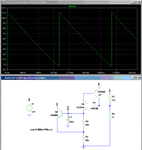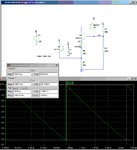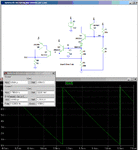neazoi
Advanced Member level 6

Hello,
I need a reverse sawtooth generator made with discrete components. It will be used to drive a varicap in a sweep generator and to trigger a scope.
I have found a similar circuit here http://www.vk2zay.net/article/196 see the first schematic of the linear voltage ramp http://www.vk2zay.net/article/file/902
Is there any way to make it such that I can get reverse pulses in the output? I do not mean negative, I mean to begin with a sharp positive edge and then to linearly decay to 0v.
I need a reverse sawtooth generator made with discrete components. It will be used to drive a varicap in a sweep generator and to trigger a scope.
I have found a similar circuit here http://www.vk2zay.net/article/196 see the first schematic of the linear voltage ramp http://www.vk2zay.net/article/file/902
Is there any way to make it such that I can get reverse pulses in the output? I do not mean negative, I mean to begin with a sharp positive edge and then to linearly decay to 0v.






